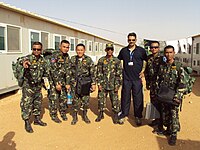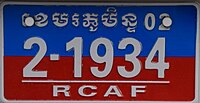| Royal Cambodian Armed Forces កងទ័ពយុទ្ធពលខេឞរភូមិន្ទ Kangtorp Yuthipol Khemarak Phumin | |
|---|---|
| Forces Armées Royales Cambodgiennes | |
 Royal Arms of Cambodia | |
| Founded | 1953 |
| Service branches |
Royal Cambodian Army Royal Cambodian Navy Royal Cambodian Air Force Royal Gendarmerie Unit |
| Headquarters | Phnom Penh |
| Leadership | |
| Commander-in-Chief | H.M. King Norodom Sihamoni |
| Minister of Defense | General Tea Banh |
| Chief of the General Staff | General Chea Saran |
| Manpower | |
| Military age | 18-60 |
| Available for military service |
3,980,995 males, age 18–49 (2010 est.), 3,970,244 females, age 18–49 (2010 est.) |
| Fit for military service |
2,751,618 males, age 18–49 (2010 est.), 2,835,807 females, age 18–49 (2010 est.) |
| Reaching military age annually |
175,497 males (2010 est.), 172,788 females (2010 est.) |
| Active personnel | 124,000 |
| Reserve personnel | 192,000 |
| Expenditures | |
| Budget | $445 million (FY01 est.) |
| Percent of GDP | 3% (2010 est.) |
| Related articles | |
| History | Military history of Cambodia |
The Royal Cambodian Armed Forces (Khmer: កងទ័ពយុទ្ធពលខេឞរភូមិន្ទ, Kangtorp Yuthipol Khemarak Phumin) (RCAF) are the national military forces of Cambodia. The Commander-in-Chief is HM King Norodom Sihamoni, and consists of the Army, Navy, Air Force and Special Forces.
The armed forces currently operate under the jurisdiction of the Ministry of National Defence. Under the constitution the RCAF is in charged of protecting the sovereignty and territorial integrity of the Kingdom of Cambodia from external threats.
The Royal Cambodian Armed Forces consists of three branches:
- Royal Cambodian Army
- Royal Cambodian Navy
- Royal Cambodian Marine Corps
- Royal Cambodian Air Force
- Royal Gendarmerie of Cambodia
The RCAF was created in 1993 by the merger of the Cambodian People's Armed Forces and the two non communist resistance armies. At the time, there were also resistance forces opposing the Government comprising the Khmer Rouge and a separate royalist resistance movement (also known as the National United Army or NUA). The forerunner of the Cambodian Armed Forces is the Division 125. It was established in 1978 by Hun Sen (now is Prime Minister) and the Vietnam People's Army's support.[1][2]
The Royal Cambodian Army is the largest force with troops stationed in each province of the country. The Royal Cambodian Navy is the second largest force and operates at sea, along the Mekong and Bassac rivers and in the Tonle Sap Lake. The military police force numbers around 7,800 employees and runs parallel to the civilian police force.
The military police have posts in every province and municipality across the country. The Royal Cambodian Air Force is the smallest of the three forces and has around 1,000 employees. The air force operates in every province with an airport.[3]
Regions[]
The RCAF command is divided geographically into five military regions and one special region. Each region includes several sub regions that correlate to civilian municipal and provincial boundaries:[3]
- Region One: Headquarters are in Stung Treng and the region covers the provinces of Stung Treng, Ratanakiri and Mondulkiri.
- Region Two: Headquarters are in Kampong Cham and the region covers the provinces of Kampong Cham, Prey Veng, Svay Rieng and Kampong Thom.
- Region Three: Headquarters are in Kampong Speu and the region covers the provinces of Kampong Speu, Takéo, Kampot, Preah Sihanouk, Koh Kong and the municipality of Kep.
- Region Four: Headquarters are in Siem Reap and the region covers the provinces of Siem Reap, Oddar Meanchey and Preah Vihear.
- Region Five: Headquarters are in Battambang and the region covers the provinces of Battambang, Pursat, Banteay Meanchey and the municipality of Pailin.
- Special Region: Headquarters are in the capital, Phnom Penh and the region covers the provinces of Kampong Chhnang, Kandal and the greater municipality of Phnom Penh.
Strength and demobilization[]

Cambodian de-mining force in Sudan.

Cambodian Marines aboard the USS Tortuga during military training.
In 2002, Prince Sisowath Sirirath, then Co-Minister of Defense, stated that the total Cambodian military strength stood around 120,000 persons.[4] With the end of fighting and the surrender of the last of the Khmer Rouge, the Cambodian military has been undergoing substantial changes as it shifts to become a peacetime force.
Since 1999, the government has been working to demobilize large numbers of servicemen with support from the World Bank. Demobilization efforts began in February 2000 and the first 2,000 soldiers were demobilized in a pilot project later that year. In 2001, the first phase of demobilization got under way and 20,000 soldiers returned to civilian life in large ceremonies around the country. A second phase of demobilization was planned for 2003 where an additional 30,000 servicemen would leave the armed forces. However, the process has been stalled by allegations of corruption and procurement irregularities.[3]
| Component | Military personnel |
| 75,000 | |
| 4,000 | |
| 2,000 | |
| 10,000 | |
| 10,000 | |
| Total | 101,000 |
History[]
Royal Khmer Armed Forces (FARK)[]

Royal Cambodian Armed Forces license plate
The Royal Khmer Armed Forces "Forces Armées Royales Khmeres" (FARK), was established on 9 November 1953 under a Franco-Khmer convention. This contributed to the termination of the French colony and protectorate, and Cambodia obtained its own authentic military organization. The FARK's roles were defined as follows: to guarantee the sovereignty of the nation and of the king; to ensure security, social order and the respect of law; and to defend the Kingdom of Cambodia. With less than 50,000 troops, FARK was organized at battalion level under the Supreme Commander of the Armed Forces, the Head of State.
Khmer National Armed Forces (FANK)[]
The military situation changed dramatically following the coup d'état in March 1970. In the Khmer Republic regime, FARK was renamed "Khmer National Armed Forces" (Forces Armées Nationales Khmeres – FANK). When the Cambodian Civil War followed, and in response to a declared state of emergency, the FANK's size was expanded to reach approximately 200,000 military personnel organized in brigades and divisions. The armed forces of all categories were placed under command and control of the President.
National Army of Democratic Kampuchea (NADK)[]
After the fall of the Khmer Republic regime in April 1975, the Khmer Rouge established a new military force called National Army of Democratic Kampuchea (NADK). It was purely composed of Khmer Rouge fighters. Similar to other forces, the NADK was organized up to division level and under command of the Chief of the General Staff.
Kampuchean People's Revolutionary Armed Forces (KPRAF)[]

Aircraft fin-flash of the People's Republic of Kampuchea
Following the intervention of the Vietnamese forces in January 1979, which resulted in the collapse of the Khmer Rouge regime and because of the effect of the Cold War, a new force was re-created in Cambodia: The Kampuchean People's Revolutionary Armed Forces, which later changed its name to the Cambodian People's Armed Forces (CPAF) of the Phnom Penh government, was rebuilt. This military organization evolved, in terms of size and organization, from battalions to divisions.
In the meantime, anti-Vietnamese movements were formed along the Cambodian-Thai border. Apart from the remained NADK, two other non-communist resistance forces, the Khmer People's National Liberation Armed Forces (KPNLAF) and the Armées Nationale pour Khmer Independent – ANKI (previously called Armées Nationale Sihanoukist – ANS) were established. The military evolution of the last two movements was similar in character: from small armed groups to divisions.
Because of the influence of the Cold War's ideological contest, and the interference of some global powers, Cambodia found itself in an insecure environment. This remained the case for more than 20 years after 1970, and was only resolved through the Peace Accords signed in Paris in October 1991.
Re-establishment of the Royal Cambodian Armed Forces[]
A legitimate national armed force, the Royal Cambodian Armed Forces, was re-established in 1993 following the creation of a democratically elected First-Term Government. The armed forces of all parties, except the NADK, were integrated into one national armed force.
In order to put security problems to an end, the Government commenced its Win Win policy in mid-1995. The policy was to end the internal security crisis through national reconciliation and national unity efforts, under the rule of the King of Cambodia. Subsequent defections NADK units began in early 1996. The Win Win policy of Samdech Prime Minister Hun Sen continued to succeed as the last groups of the Khmer Rouge guerrillas were integrated into the RCAF in late 1998. It historically marked the total dissolution of the Khmer Rouge's political and military organs and the return of all secession areas to government control.
The RCAF now has to continue reforms, so as to be in-line with the Government's political guidelines. These guidelines direct the armed forces to demobilize to an acceptable size, achieve sound capability, and inculcate high ethics and dignity, with advancement towards international standardization in the future. The RCAF also has to plan for its agenda to include security cooperation for the common benefit of the whole region.
Royal Gendarmerie of Cambodia[]
The Royal Gendarmerie of Cambodia is a paramilitary unit with about 10,000 soldiers deployed in all provinces. It is head quartered in Phnom Penh. The unit's chain of command is through the Royal Cambodian Armed Forces High Command and commanded by a Lieutenant General, currently Lt-General Sao Sokha. The Royal Gendarmerie of Cambodia is deployed in every province and cities to keep law and order. After the penal procedure code had been passed the military police in Cambodia play an important role in Cambodia society which keep law and orders in cities like the National Police, an important tasks that had been revoked sub decree in 2002. Every provincial gendarmerie is commanded by a colonel, after 1 January 2009 by a brigadier general, except in the capital of Phnom Penh where it is commanded by brigadier general since it is created. [5]
See also[]
- Kampuchean People's Revolutionary Armed Forces
- History of Cambodia
- Cambodian Civil War
- Lon Nol
- Khmer Republic
- Khmer National Armed Forces
- Weapons of the Cambodian Civil War
- Khmer Rouge
- Meas Sophea
- Hun Sen
References[]
| Wikimedia Commons has media related to Military of Cambodia. |
- ↑ http://www.tuoitrenews.vn/cmlink/tuoitrenews/politics/memorial-symbolises-vietnam-cambodia-ties-1.57111
- ↑ http://news.gov.vn/Home/National-historical-relic-inaugurated-in-Dong-Nai/20121/12901.vgp
- ↑ 3.0 3.1 3.2 Ian Ramage, Strong Fighting: Sexual Behavior and HIV/AIDS in the Cambodian Uniformed Services, 2002
- ↑ Cambodia Daily 3 September 2001
- ↑ RGC Official site
Further reading[]
- Dylan Hendrickson, 'Cambodia's security-sector reforms: limits of a downsizing strategy,' Conflict, Security, and Development, Volume 1, Issue 1.
- Gerald Segal and Mats Berdal, 'The Cambodia Dilemma,' Jane's Intelligence Review, March 1993, p. 131-2. Includes listing of formations and equipment of the various factions.
- Robert Karniol, 'Confined to local waters,' Naval Forces Update, Jane's Defence Weekly, 20 June 1992, p. 1097. Status of Cambodian navy.
| ||||||||||||||||||||||||||||||||||||||
| |||||||||||
External links[]
High Command Badge https://www.militaria-agent.com/catalog/CAMBODIA_DIRECTORY_OF_THE_HIGH_COMMAND_BADGE_SUBORDINATED_TO_THE_MINISTRY.html
The original article can be found at Royal Cambodian Armed Forces and the edit history here.
